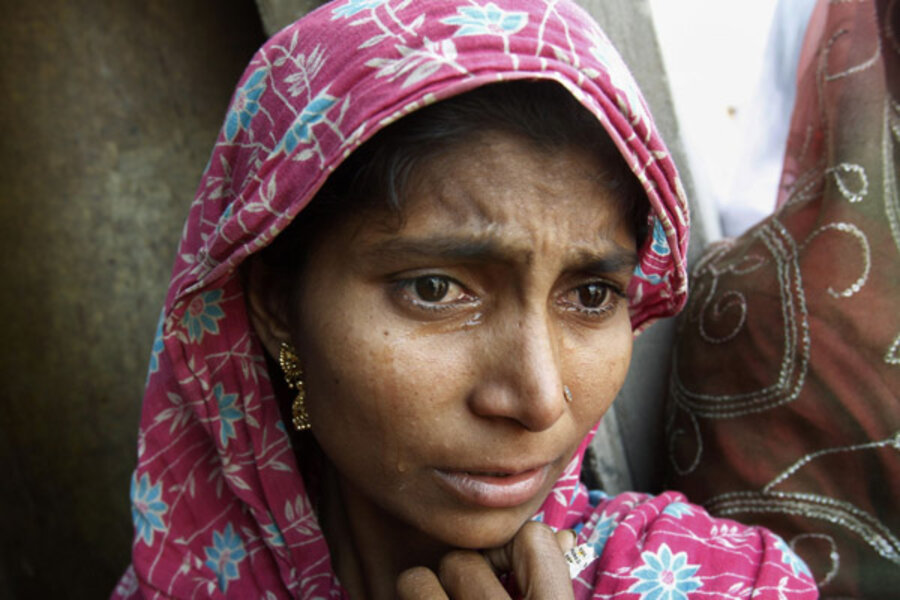World's most dangerous locales for women: Why is India so high on the list?
Loading...
| Kabul, Afghanistan
A study released this week named Afghanistan the most dangerous country for women, with Pakistan and India following closely behind. But while serious problems exist for women in these places, women’s rights activists say there is also an emerging public awareness in all three countries about problems that were previously seen as too taboo to address in public.
“If you look at the Bollywood films and you see the fashion magazines coming out of both countries [Pakistan and India], you wouldn’t believe that there are other women locked up at home or their mobility is severely curtailed, but that is the case,” says Simi Kamal, chief of party for the gender equity program at the Aurat Foundation, headquartered in Islamabad.
“On the one hand, you will see many women out in the professional world – they own businesses, they’re in the banking sector, they’re in the teaching sector, all of those things – yet there are other women who have to face a whole series of harassments.”
The findings were released on Wednesday based on a poll conducted by TrustLaw, the Thomson Reuters Foundation’s legal news service. It asked 213 gender experts to rank countries by the perception of danger to women. It also looked at threats related to health, sexual violence, nonsexual violence, cultural or religious factors, lack of access to resources, and trafficking. The Democratic Republic of Congo was listed as the second most-dangerous country for women.
Afghanistan
Women’s issues in Afghanistan have long been at the forefront of international human rights concerns. Especially during the rule of the Taliban, abuses were extremely well-documented.
Experts say there has been some progress over the past 10 years, with women increasingly taking roles in politics. Still, Afghan women, especially those in rural areas, face a number of rights abuses, such as forced marriages or being traded between families to settle disputes.
“Our government is not able to provide the rights to women, which they have in the law of Afghanistan. And women do not even have access to the rights that Allah gives them in our sharia [Islamic] law,” says Lal Gul Lal, chairman of the Afghanistan Human Rights Organization.
Some of the biggest threats facing women come from a dearth of infrastructure after three decades of conflict. One in 11 women die during childbirth and 87 percent of women are illiterate, according to the report.
According to some women's activists in Afghanistan, this latest report approaches women’s issues through a Western cultural lens and ignores the main issues facing the nation.
“If they stopped the war, money could go to make hospitals and provide education to women. Our children grew up on the streets because of this stupid war,” says Fatana Ishaq Gailani, founder and chairwoman of the Afghanistan Women Council in Kabul.
She argues that, health and access to education aside, from a cultural standpoint that Afghan women are far better off than Western women who appear “on television in ice cream ads, go out alone without men, and they have so many boyfriends.”
India and Pakistan
In India and Pakistan, there is some relief that at least the problems facing women are entering the public discourse.
Pakistan was listed as the third worst place for women due to violent abuse and child and forced marriages, among other issues. In India, female feticide, trafficking, and child marriages were listed as the biggest problems resulting in its ranking as No. 4.
“We used to think of the domestic space as closed off, where all forms of violence were possible and the state could not step across the threshold of a private door. That no longer exists. The state and its laws are very much present in the domestic space,” says Radhika Chopra, a sociologist at Delhi University.
India’s willingness to report the problem of trafficking may make it appear worse than other countries that are less transparent, wrote the authors of TrustLaw’s report. Some 100 million people, mostly women and girls, are involved in trafficking in India.
Though there have been improvements in the legal framework developed to protect women, activists in both India and Pakistan report that, as with Afghanistan, those charged with enforcing the laws still show strong cultural prejudice.
“The laws aren’t always followed as they should be, because there are biases that exist in the police, in the court system, and the organizations and counselors who deal with women who have suffered violence. So then it becomes a mindset that is not prepared to accept women as equals or their bid for freedom,” says Mrs. Kamal.





